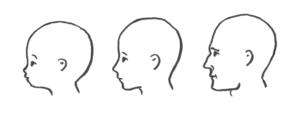This is an old revision of this page, as edited by 24.159.229.168 (talk) at 05:40, 22 September 2008. The present address (URL) is a permanent link to this revision, which may differ significantly from the current revision.
Revision as of 05:40, 22 September 2008 by 24.159.229.168 (talk)(diff) ← Previous revision | Latest revision (diff) | Newer revision → (diff) "Cute" redirects here. For other uses, see Cute (disambiguation).
Cuteness is a kind of attractiveness commonly associated with youth and appearance, as well as a scientific concept and analytical model in ethology, first introduced by Konrad Lorenz. It is usually characterized by (though not limited to) some combination of infant-like physical traits, especially small body size with a disproportionately large head, large eyes, a small nose, dimples, and round and softer body features. Infantile personality traits, such as playfulness, fragility, helplessness, curiosity, innocence, affectionate behavior and a need to be nurtured are also generally considered cute.

Konrad Lorenz argued in 1949 that infantile features triggered nurturing responses in adults and that this was an evolutionary adaptation which helped ensure that adults cared for their children, ultimately securing the survival of the species. As evidence, Lorenz noted that humans react more positively to animals that resemble infants—with big eyes, big heads, shortened noses, etc.—than to animals that do not.
That is, humans prefer animals which exhibit pedomorphosis. Pedomorphosis is the retention of child-like characteristics—such as big heads or large eyes—into adulthood. Thus, pedomorphosis and cuteness may explain the popularity of Giant Pandas and Koalas. The widely perceived cuteness of domesticated animals, such as dogs and cats, may be due to the fact that humans selectively breed their pets for infant-like characteristics, including non-aggressive behavior and child-like appearance.
Some later scientific studies have provided further evidence for Lorenz's theory. For example, it has been shown that human adults react positively to infants who are stereotypically cute. Studies have also shown that responses to cuteness—and to facial attractiveness generally—seem to be similar across and within cultures.
Additionally, the phenomenon is not restricted to humans. The young of many mammal and bird species share a similar set of typical physical proportions, beyond absolute body size, that distinguish them from adults of their own species. "Cute" features were also described in the recent finding of a baby Triceratops skull, suggesting that cuteness is an ancient and useful survival technique.
Cultural significance
Cuteness is a major marketing tool in many cultures, such as that of Japan, with phenomena such as Pokémon or Hello Kitty. It is also an important selling point in the English-speaking world, where Elmo, Furby, Precious Moments, and many other cultural icons and products trade on their cuteness. It can be a factor in live action productions such as movies starring Shirley Temple, the Honey, I Shrunk The Kids trilogy, the Three Men and a Baby duology, and elements of One Good Cop, as well the successful documentary film March of the Penguins, where the noteworthy cuteness of the penguins was cited as a major reason for the film's outstanding appeal. This technique was repeated in the computer-animated film Happy Feet.
Stephen Jay Gould remarked on this phenomenon in an article for the journal Natural History, in which he pointed out that over time Mickey Mouse had been drawn more and more to resemble an infant—with bigger head, bigger eyes, and so forth. Gould suggested that this change in Mickey's image was intended to increase his popularity by making him appear cuter.
References
- In pictures: Polar bear Knut is growing up - see 2nd picture
- http://www.winchester.ac.uk/view.ashx?Item=15993
- 03.06.2006 - Smallest Triceratops skull described
See also
Further reading
- Stephen Jay Gould. A Biological Homage to Mickey Mouse, in The Panda's Thumb: More Reflections in Natural History. W.W. Norton & Company, 1980. (web version)
- Konrad Lorenz. Part and Parcel in Animal and Human Societies, in Studies in animal and human behavior, vol. 2. pp. 115-195. Cambridge, Mass.: Harvard UP, 1971 (originally pub. 1950).
- Natalie Angier. The Cute Factor. The New York Times, 2006-01-03.
- Jeanne Moos. The Science of Cuteness/Cutie Contest, CNN Headline News, 2006-12-17. video
- Ilya Garger. Hello Kitty: One Nation Under Cute. Psychology Today, Mar/Apr 2007.
- Richmond, Antonia (April 2, 2006). "Animal Rites -- Canine culture goes over the top". SFGate.com. Retrieved 2008-08-29.